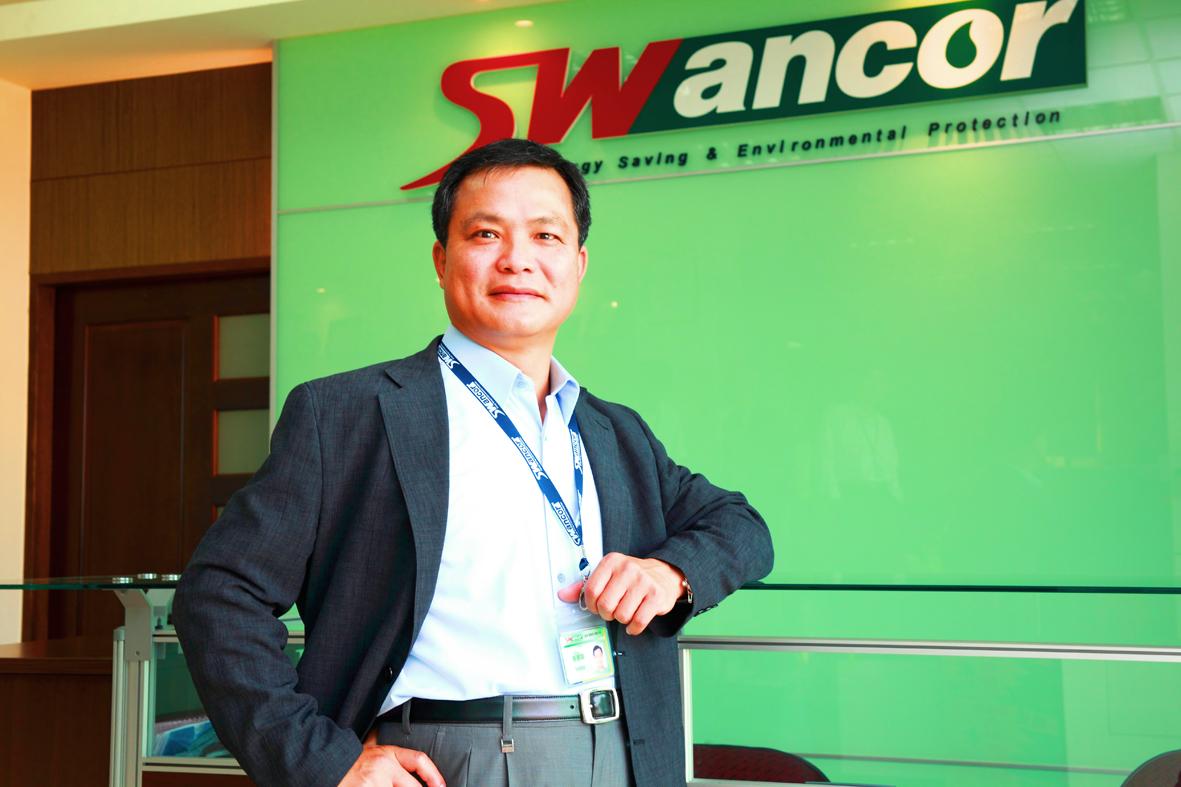Resins and composite materials manufacturer Swancor Holding Co Ltd (上緯投控) expects this quarter’s revenue to remain the same as last quarter despite the effects of traditional seasonality, after last quarter’s revenue was the highest in the company’s history.
Third-quarter revenue was NT$3.01 billion (US$104.44 million), up 27.5 percent from the previous quarter and 95.7 percent from a year earlier, due to increased orders for its wind power resins and carbon-fiber composite materials, the company told an investors’ conference in Taipei on Thursday.
The company’s fine chemicals business reported that its revenue last quarter rose 66.22 percent year-on-year to NT$2.51 billion, accounting for 83 percent of Swancor’s overall revenue, while its carbon fiber business reported that revenue surged 1,570 percent to NT$501 million, contributing 17 percent of its total revenue.

Photo: Chang Hui-wen, Taipei Times
Swancor’s better-than-expected sales outlook for this quarter came after its consolidated revenue for last month reached a record high of NT$1.16 billion, up 3.76 percent month-on-month and 118.04 percent year-on-year.
The company’s revenue has reached record highs for seven consecutive months, indicating sustained order growth and bringing cumulative revenue in the first 10 months to NT$5.15 billion — an annual increase of 48.03 percent, it said.
Swancor chairman Robert Tsai (蔡朝陽) said that the company remains positive about its outlook for next year, forecasting that sales of its carbon-fiber composite materials would grow as much as 80 percent, and sales of its environmental protection and anti-corrosion materials would increase 10 to 20 percent.
As for sales of wind turbine blade resins, Tsai said that the company expects to maintain flat growth in China this year, but it has nonetheless secured two clients outside of China to help contribute to its revenue next year.
The company’s goal is to become a world leader of wind power materials by 2022 and secure more than 25 percent of Asia’s anti-corrosion materials market by 2025, Tsai said.
The company also aims to take more than 25 percent of the global blade materials market and 30 percent of the global market for carbon-fiber composite materials used for wind power by 2025, he added.
Swancor’s carbon-fiber composite materials business would continue to benefit from wind turbines getting larger and the rapid growth of offshore wind power demand, analysts said.
The company would likely penetrate the supply chain of international vendors, as it has received orders from MHI Vestas Offshore Wind A/S, they said.
Swancor reported net profit of NT$221.19 million in the third quarter, down 11.2 percent quarter-on-quarter, but up 381 percent year-on-year. That translated into earnings per share of NT$2.41.
In the first three quarters, net profit totaled NT$516.22 million, up from NT$462.52 million a year earlier, while earnings per share were NT$5.63 over the period.

Taiwan’s long-term economic competitiveness will hinge not only on national champions like Taiwan Semiconductor Manufacturing Co. (TSMC, 台積電) but also on the widespread adoption of artificial intelligence (AI) and other emerging technologies, a US-based scholar has said. At a lecture in Taipei on Tuesday, Jeffrey Ding, assistant professor of political science at the George Washington University and author of "Technology and the Rise of Great Powers," argued that historical experience shows that general-purpose technologies (GPTs) — such as electricity, computers and now AI — shape long-term economic advantages through their diffusion across the broader economy. "What really matters is not who pioneers

In a high-security Shenzhen laboratory, Chinese scientists have built what Washington has spent years trying to prevent: a prototype of a machine capable of producing the cutting-edge semiconductor chips that power artificial intelligence (AI), smartphones and weapons central to Western military dominance, Reuters has learned. Completed early this year and undergoing testing, the prototype fills nearly an entire factory floor. It was built by a team of former engineers from Dutch semiconductor giant ASML who reverse-engineered the company’s extreme ultraviolet lithography (EUV) machines, according to two people with knowledge of the project. EUV machines sit at the heart of a technological Cold

TAIWAN VALUE CHAIN: Foxtron is to fully own Luxgen following the transaction and it plans to launch a new electric model, the Foxtron Bria, in Taiwan next year Yulon Motor Co (裕隆汽車) yesterday said that its board of directors approved the disposal of its electric vehicle (EV) unit, Luxgen Motor Co (納智捷汽車), to Foxtron Vehicle Technologies Co (鴻華先進) for NT$787.6 million (US$24.98 million). Foxtron, a half-half joint venture between Yulon affiliate Hua-Chuang Automobile Information Technical Center Co (華創車電) and Hon Hai Precision Industry Co (鴻海精密), expects to wrap up the deal in the first quarter of next year. Foxtron would fully own Luxgen following the transaction, including five car distributing companies, outlets and all employees. The deal is subject to the approval of the Fair Trade Commission, Foxtron said. “Foxtron will be

INFLATION CONSIDERATION: The BOJ governor said that it would ‘keep making appropriate decisions’ and would adjust depending on the economy and prices The Bank of Japan (BOJ) yesterday raised its benchmark interest rate to the highest in 30 years and said more increases are in the pipeline if conditions allow, in a sign of growing conviction that it can attain the stable inflation target it has pursued for more than a decade. Bank of Japan Governor Kazuo Ueda’s policy board increased the rate by 0.2 percentage points to 0.75 percent, in a unanimous decision, the bank said in a statement. The central bank cited the rising likelihood of its economic outlook being realized. The rate change was expected by all 50 economists surveyed by Bloomberg. The